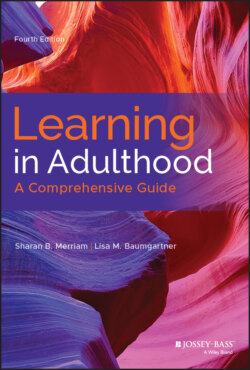Читать книгу Learning in Adulthood - Sharan B. Merriam - Страница 48
Employment and Life Transitions as Motives
ОглавлениеHundreds of local, state, and national studies have asked adults their reasons for engaging in educational pursuits. In most of these studies, respondents are presented with a list of reasons why people might participate in organized learning activities and asked to indicate which ones apply to them. Most respondents report multiple reasons. If asked to indicate the main reason (as they were in the NCES surveys), however, they most commonly cite job-related motives.
The strength of employment-related motives was first uncovered by Johnstone and Rivera (1965). Thirty-six percent of respondents indicated that they were “preparing for a new job or occupation” (p. 144), and 32% said they participated in education “for the job I held at that time.” The authors concluded that “vocational goals most frequently direct adults into continuing education” (p. 144). The 11 surveys of participation conducted by the NCES have consistently revealed job-related reasons as the most frequently cited.
In a study conducted by the United Nations Educational, Scientific, and Cultural Organization (UNESCO; Valentine, 1997), fully 90.6% of those surveyed in the United States cited career- or job-related reasons for participation and 9.4% cited “personal interest.” When asked about the goal of the learning activity, the largest percentage (58%) said it was professional or career upgrading, 18.3% “other,” 17.6% to earn a college or university degree, 3.8% to earn a vocational or apprenticeship certificate, and 2.3% to complete secondary school (Valentine, 1997). Clearly, there is a strong linkage between one's work life and participation in adult education.
Approaching people's reasons for participating in adult education from a somewhat different angle, Aslanian and Brickell (1980) sought to test the hypothesis that life transitions motivate adults to seek out learning experiences. Of the 1,519 adults over age 25 randomly sampled, 744, or 49%, reported having learned something formally or informally in the year prior to the study. They found that 83% of the learners in their sample could describe some past, present, or future change in their lives as reasons for learning. The other 17% were engaged in learning for its own sake—that is, to stay mentally alert—or for the social aspects or because learning is a satisfying activity. Those going through transitions, such as marriage, retirement, job changes, birth of children, and so on, were able to identify specific events, such as getting fired or promoted, that triggered their transition. The authors noted seven kinds of transitions. Those relating to career and family accounted for 56% and 16% of the transitions, respectively. The other transitions, in descending importance, concerned leisure (13%), art (5%), health (5%), religion (4%), and citizenship (1%). “To know an adult's life schedule,” the authors conclude, “is to know an adult's learning schedule” (pp. 60–61).
In a similarly designed study, Aslanian (2001) also found that participation in higher and continuing education is largely due to a life transition. Of seven possible transitions, 85% named a career transition as their reason for wanting to learn, and hence participate, in higher and continuing education courses.
The survey studies have been helpful in identifying the reasons adults give for participating in learning activities. Because the majority of adult learners are employed or looking for work (only 28% of adults surveyed in the 2004–2005 NCES study reported not being in the labor force) and derive much of their identity from their work, it is not surprising to find that at least half of them are involved in education for job-related reasons. Other investigations have sought to go beyond these self-reported data in trying to understand the why of participation.
